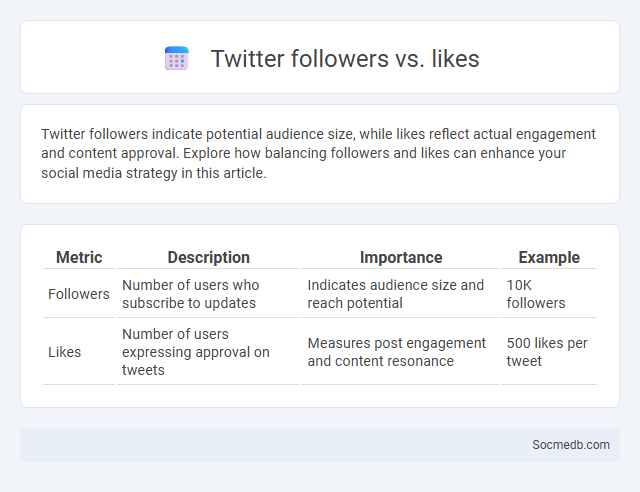
Photo illustration: Twitter followers vs likes
Twitter followers indicate potential audience size, while likes reflect actual engagement and content approval. Explore how balancing followers and likes can enhance your social media strategy in this article.
Table of Comparison
| Metric | Description | Importance | Example |
|---|---|---|---|
| Followers | Number of users who subscribe to updates | Indicates audience size and reach potential | 10K followers |
| Likes | Number of users expressing approval on tweets | Measures post engagement and content resonance | 500 likes per tweet |
Understanding Twitter: Followers vs Likes
Twitter engagement metrics reveal distinct insights: followers indicate the size of an audience attracted to an account, while likes represent direct approval of specific content. High follower counts suggest broad reach potential, but consistent likes demonstrate audience interaction and content relevance. Marketers prioritize both metrics to balance visibility with genuine user engagement for effective campaign strategies.
The Importance of Twitter Followers
Twitter followers play a crucial role in amplifying your message and expanding your digital influence by increasing the reach and engagement of your tweets. A large, active follower base signals credibility and trustworthiness, which can attract partnerships, business opportunities, and brand recognition. By growing your Twitter followers, you enhance your ability to connect with a targeted audience and drive meaningful interactions that support your personal or professional goals.
The Role of Likes in Twitter Engagement
Likes on Twitter serve as a crucial metric for measuring audience engagement and content resonance, directly influencing the visibility of tweets through the platform's algorithm. High numbers of likes enhance the likelihood of content being featured in users' timelines and trending topics, amplifying reach and brand presence. Twitter analytics leverage like counts to provide insights into audience preferences, guiding strategic content creation and targeted marketing efforts.
Differences Between Followers and Likes
Followers represent the total number of users who have opted to receive updates from a social media account, indicating a sustained interest or connection with the content creator. Likes are temporary, specific engagements expressing approval on individual posts, reflecting momentary reactions rather than long-term support. The distinction highlights that while followers measure audience size and loyalty, likes quantify content popularity and immediate interaction.
How Followers Impact Your Twitter Presence
Followers significantly enhance your Twitter presence by increasing the visibility and reach of your tweets, resulting in higher engagement rates and expanded audience interactions. A larger follower base boosts social proof, attracting even more users to follow and engage with your content, thereby amplifying your influence within your niche. Consistent follower growth supports algorithmic favorability, making your tweets more likely to appear in timelines, trending topics, and search results.
Why Twitter Likes Matter
Twitter likes serve as a key metric indicating audience engagement and content relevance, boosting a tweet's visibility through algorithmic promotion. High like counts enhance social proof, increasing credibility and attracting more followers, which supports brand growth. Marketers and influencers leverage likes to gauge real-time feedback, informing content strategies and improving user interaction effectively.
Engagement Metrics: Followers vs Likes
Engagement metrics on social media weigh the significance of followers against likes, with followers indicating potential reach while likes reflect immediate content interaction. A high follower count does not always guarantee active engagement, making likes a crucial indicator of content resonance and user interest. Brands and influencers analyze both metrics to measure audience loyalty and the effectiveness of their social media strategies.
Strategies to Grow Twitter Followers and Likes
Effective strategies to grow Twitter followers and likes include consistently posting high-quality, relevant content that resonates with your target audience, utilizing trending hashtags to increase visibility, and engaging actively with followers through replies and retweets. Collaborating with influencers and participating in Twitter chats can also boost follower count and enhance engagement rates. Monitoring analytics tools helps optimize posting times and content types, maximizing reach and interaction.
Measuring Success: Which Metric Counts the Most?
Engagement rate remains the most critical metric for measuring social media success, reflecting genuine interaction through likes, comments, shares, and saves. Reach and impressions quantify visibility, but engagement reveals the quality of audience connection and content relevance. Tracking conversion rates ties social media efforts directly to business outcomes like sales, sign-ups, or lead generation, providing a comprehensive success indicator.
Balancing Followers and Likes for Maximum Impact
Balancing followers and likes requires a strategic approach to content quality and engagement frequency that aligns with your target audience's preferences. Prioritizing meaningful interactions over merely increasing numbers enhances social proof and algorithmic favorability, boosting overall visibility on platforms like Instagram, Facebook, and TikTok. Your ability to foster authentic connections solidifies credibility and amplifies your social media impact.
 socmedb.com
socmedb.com